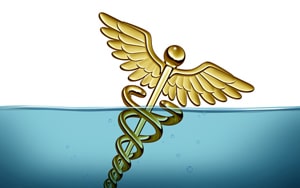
July 20, 2015
The Problem With Healthcare—Part 1
By Michael D. Shaw
As we approach the 50th anniversary of President Lyndon Johnson signing the Medicare bill into law (July 30th), what better time to consider the seemingly intractable problem of healthcare? FDR tried to include a federal health insurance component into the Social Security Act of 1935, but backed off. Harry Truman, his successor, took up the cause again in 1945, 1947, and 1949. JFK would pick up the banner in 1961.
During the 1965 signing, LBJ called the 81-year-old Truman “the real daddy of Medicare,” and presented him and his wife Bess with the first two Medicare cards.
With the passage of Medicare, the terms “healthcare” and “health insurance” became so increasingly related, that with the 2010 passage of Obamacare (Affordable Care Act), for many folks, the terms are now interchangeable. And, more’s the pity; because these days, quality of outcome is nowhere near as important as who pays for it. Beyond who is paying for it, and how much they are paying, we also have the definition of “it.” That is, what sorts of procedures will be covered, which will be excluded, and how are those decisions being made?
In the early 1960s, the American Medical Association led the charge against what it called “socialized medicine,” using Ronald Reagan as a key spokesman. Among other zingers, Reagan stated that such a program would “invade every area of freedom in this country” and would, in years to come, have Americans waxing wistful to future generations about “what it was like in America when men were free.” Needless to say, Reagan was widely mocked at the time by all the usual suspects, and a few years later by the execrable Pat Brown during his unsuccessful gubernatorial re-election campaign.
Jimmy Carter would invoke the same tone in his re-election campaign, calling Reagan a “traveling salesman for the American Medical Association campaign against Medicare.” Apparently, this was not an effective strategy, as Carter lost the electoral vote 489-49, and the popular vote by ten percent.
In light of provisions of Obamacare whereby everyone is forced to purchase health insurance, millions have been pushed into Medicaid, and options are limited by design, no one is mocking Reagan’s words anymore. Moreover, contrary to the assurances of the Feds, Medicare had an almost immediate effect on how all health insurance would be administered, not to mention how care itself would be delivered.
Ironically, the AMA would become a major facilitator of socialized medicine with its CPTs (Current Procedural Terminology) and RUC (Relative Value Scale Update Committee).
The CPT is a code set—copyrighted by the AMA—describing medical, surgical, and diagnostic services and is designed to communicate uniform information about medical services and procedures among physicians, coders, patients, accreditation organizations, and payers for administrative, financial, and analytical purposes.
The RUC advises Centers for Medicare and Medicaid Services (CMS) on reimbursement rates for medical procedures. Bearing in mind that virtually all third party payers follow these guidelines, the RUC sets the rates for essentially all medical procedures performed in the US. Among its many faults, the RUC massively favors procedural medicine over cognitive medicine, so that primary care physicians basically get screwed. All by itself, this distortion of the healing arts effectively guts meaningful funding for, and focus on preventive medicine.
Despite, or very likely because of the CPTs, RUC, and DRGs (Diagnosis Related Groups), there is still a staggering amount of Medicare, Medicaid, and private insurance fraud.
As if this weren’t bad enough, any number of billable procedures such as mammography and colonoscopies are viewed as “preventive” services. No one has ever explained how detecting a disease in its early stages qualifies as “preventive.” Of course, the working answer to this question is the notion of five-year survival rates.
The five-year survival rate is calculated from the time the disease is first detected. Thus, if a microscopic breast tumor is discovered in a woman, and she undergoes therapy, but dies five years and one day after it was first detected, she is a “winner.”
So, here’s where we currently stand: Health insurance equals healthcare; outcomes are far less important than having someone else pay for your healthcare; primary care providers are discriminated against; the reimbursement system encourages fraud; and preventive medicine barely exists. What could possibly go wrong?
